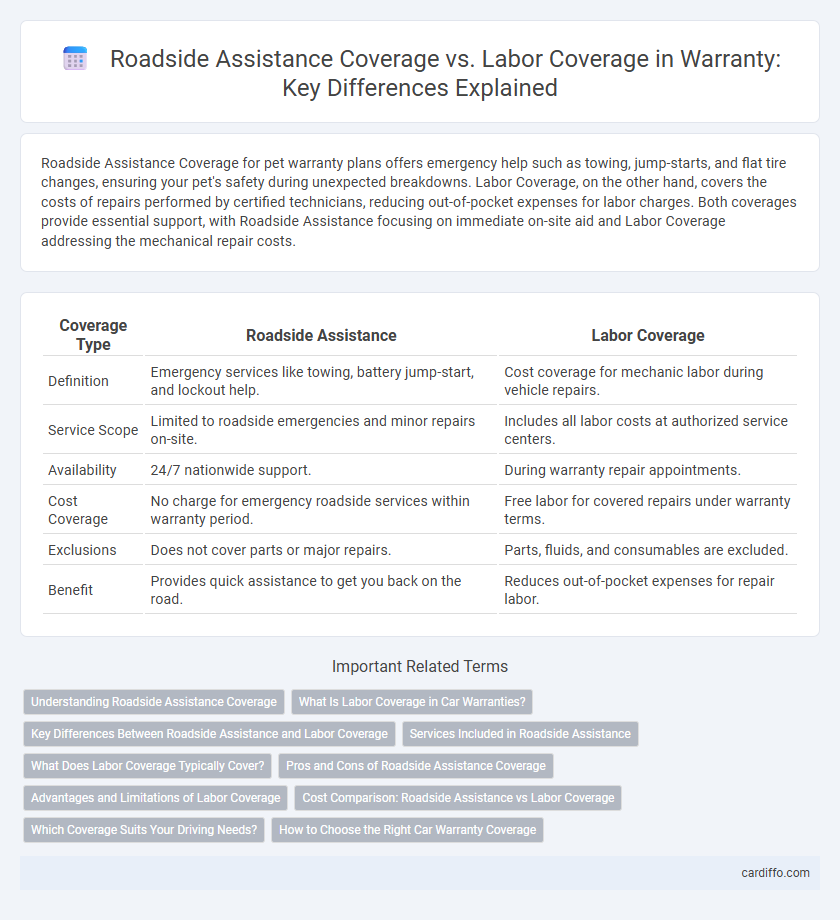Roadside Assistance Coverage for pet warranty plans offers emergency help such as towing, jump-starts, and flat tire changes, ensuring your pet's safety during unexpected breakdowns. Labor Coverage, on the other hand, covers the costs of repairs performed by certified technicians, reducing out-of-pocket expenses for labor charges. Both coverages provide essential support, with Roadside Assistance focusing on immediate on-site aid and Labor Coverage addressing the mechanical repair costs.
Table of Comparison
| Coverage Type | Roadside Assistance | Labor Coverage |
|---|---|---|
| Definition | Emergency services like towing, battery jump-start, and lockout help. | Cost coverage for mechanic labor during vehicle repairs. |
| Service Scope | Limited to roadside emergencies and minor repairs on-site. | Includes all labor costs at authorized service centers. |
| Availability | 24/7 nationwide support. | During warranty repair appointments. |
| Cost Coverage | No charge for emergency roadside services within warranty period. | Free labor for covered repairs under warranty terms. |
| Exclusions | Does not cover parts or major repairs. | Parts, fluids, and consumables are excluded. |
| Benefit | Provides quick assistance to get you back on the road. | Reduces out-of-pocket expenses for repair labor. |
Understanding Roadside Assistance Coverage
Roadside Assistance Coverage provides critical support such as towing, lockout services, tire changes, and fuel delivery, ensuring drivers are not stranded during vehicle breakdowns. This coverage differs from Labor Coverage, which specifically covers the cost of mechanical repairs and service work performed on the vehicle. Understanding Roadside Assistance Coverage helps vehicle owners maintain peace of mind by securing prompt emergency help outside typical repair warranties.
What Is Labor Coverage in Car Warranties?
Labor coverage in car warranties refers to the protection that covers the cost of skilled technician work required to repair or service your vehicle, excluding the parts or materials used. This coverage ensures that if a mechanical failure occurs within the warranty period, the labor expenses for diagnosing and fixing the issue are paid by the warranty provider. Unlike roadside assistance, which handles emergency support and minor on-the-spot repairs, labor coverage focuses on comprehensive repairs performed in an authorized service center.
Key Differences Between Roadside Assistance and Labor Coverage
Roadside assistance coverage primarily offers emergency services such as towing, battery jump-starts, and flat tire changes, designed to get drivers back on the road quickly. Labor coverage covers the cost of mechanic work required to repair or maintain a vehicle, including inspections, diagnostics, and repairs performed at a service facility. The key difference lies in roadside assistance addressing immediate, on-the-spot emergencies, while labor coverage deals with the professional service work needed after a vehicle reaches a repair shop.
Services Included in Roadside Assistance
Roadside assistance coverage includes crucial services such as towing, battery jump-starts, flat tire changes, lockout assistance, and fuel delivery, ensuring drivers are supported during unexpected vehicle breakdowns. This coverage focuses on immediate, on-the-spot assistance rather than repair costs, which fall under labor coverage. Understanding these distinctions helps vehicle owners maximize warranty benefits while minimizing out-of-pocket expenses during roadside emergencies.
What Does Labor Coverage Typically Cover?
Labor coverage in a vehicle warranty typically includes the cost of mechanic hours required to diagnose and repair covered mechanical failures or defects. This coverage often encompasses tasks such as engine repairs, transmission work, brake system maintenance, and electrical system troubleshooting. Roadside assistance coverage, in contrast, generally covers emergency services like towing, jump-starts, flat tire changes, and lockout services but does not pay for actual repair labor.
Pros and Cons of Roadside Assistance Coverage
Roadside Assistance Coverage offers valuable benefits such as emergency towing, battery jump-starts, and lockout services, ensuring immediate help during unexpected breakdowns. However, it typically does not cover vehicle repair labor costs, which means owners may still face out-of-pocket expenses for actual mechanical repairs. Choosing Roadside Assistance Coverage provides peace of mind for urgent roadside issues but does not replace comprehensive labor coverage needed for vehicle maintenance and repairs.
Advantages and Limitations of Labor Coverage
Labor coverage under a warranty ensures that the costs associated with diagnostic work and repairs performed by certified technicians are fully paid, reducing out-of-pocket expenses for vehicle owners. However, labor coverage typically excludes services provided outside authorized repair shops, limiting access to roadside repairs or emergencies where immediate assistance is critical. This coverage is most advantageous for extensive repairs requiring skilled labor but may not address urgent roadside assistance needs, which are usually covered under a separate roadside assistance plan.
Cost Comparison: Roadside Assistance vs Labor Coverage
Roadside assistance coverage typically incurs lower premium costs compared to labor coverage due to its limited scope, primarily focusing on emergency services like towing and battery jumps. Labor coverage involves higher expenses since it covers extensive repair work by certified technicians, which significantly increases claim payouts. Consumers should evaluate their vehicle maintenance needs and driving habits to balance the cost-benefit ratio between affordable roadside assistance and comprehensive labor coverage.
Which Coverage Suits Your Driving Needs?
Roadside Assistance Coverage provides emergency services such as towing, fuel delivery, and flat tire changes, ideal for drivers who prioritize peace of mind during unexpected breakdowns. Labor Coverage covers the cost of repairs performed by mechanics, making it suitable for those who want financial protection against costly vehicle repairs. Choosing between these coverages depends on whether you value immediate roadside help or long-term repair expense protection.
How to Choose the Right Car Warranty Coverage
Choosing the right car warranty coverage involves evaluating the importance of roadside assistance coverage, which offers emergency services like towing and flat tire changes, versus labor coverage that reimburses repair work costs. Analyze your driving habits, vehicle reliability, and budget to determine whether you prioritize immediate help during breakdowns or long-term repair cost protection. Selecting a warranty that balances both coverage types can maximize peace of mind and financial savings over your vehicle's lifespan.
Roadside Assistance Coverage vs Labor Coverage Infographic

 cardiffo.com
cardiffo.com